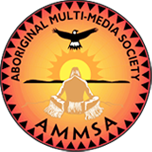Article Origin
Volume
Issue
Year
Page 8
He's been one busy man with art tours in Japan, Germany and Australia where the work of George Littlechild, a 40-year-old Cree artist from Alberta's Hobbema First Nation is described as very exotic.
A feature show at Edmonton's Bearclaw Gallery promoted as the Prayer Offering and Otherwise showcased Littlechild's art. Most of his work is selling at exhibitions mainly in Ottawa, Hull, Vancouver, Kamloops and Seattle. Littlechild makes his home in Vancouver.
The April 19 opening of his 18-piece exhibit and sale at the Bearclaw attracted a sizable gathering where seven of his originals were snapped up. Working primarily in acrylic on canvas and mixed media, it was a pleasant return to his roots, his territory and a city he has not visited for eight years.
In that time, Littlechild has prospered. He's opened his own gallery and there have been three books about him that feature his art work. This Land is my Land (1993), A Man Called Raven (1997), and recently, What's The Most Beautiful Thing You Know About Horses.
Born to Rachel Littlechild and James Price, Littlechild was farmed out to five foster homes from the time he was born.
Littlechild stayed with the same family during the time he was 4 years old until he turned 18. He credits his foster family for the work he now pursues as his chosen profession. It's a profession he has a true passion for, one that allows him to make social statements about Aboriginal people and issues, said Littlechild.
His foster mother, who drove him to art class as a child, influenced him strongly.
"She was always there, she forced me to get there and said, 'You do your art,'" said Littlechild.
She also informed him in later years, that at four years of age, he was already doing art, he said.
Another influence came from master artist Marc Chagall from Europe who was an inspiration.
"His style was whimsical, dream-like," said Littlechild. He also respects the works of a fellow Aboriginal artist Joanne Cardinal-Schubert whose themes parallel those of Littlechild. However, he doesn't like being branded as just "an Aboriginal artist."
What Littlechild appreciates is recognition as an artist without any race attached to the designation. Littlechild says his favorite subjects are people who are under-dogs.
"Classically, I'm being an educator," he said.
He works in bold colors, using a lot of reds, pinks, purples, yellow and turquoise, with more blues now, he states. And, like many of his contemporaries, his art now incorporates text and photography.
The themes that are somewhat constant in his art focus on residential schools, spirituality, education, human relationships and things that deal with our lives, both positive and negative, he said.
Much of his art answers who and what we are, and how we came to be the spirits that we are, he said.
One particular personality that crops up in some of his art is Bobtail, one of the original Cree chiefs in the Hobbema area around the time of the treaties. He was a great, great, great uncle to Littlechild and once had his own reserve, but moved to Calgary only to discover the buffalo were gone.
Bobtail returned to Hobbema, but lost most of his band members who eventually wound up on the Montana Reserve at Hobbema. Bobtail is one of people that Littlechild reveres.
"Whose will to live, survive and experience life, especially today, and their ability and will to survive is tremendous," he said.
"They (his pictures) are about foster children from the '60s; there's a hundred, thousand of us that were taken. A lot of people don't know about us," said Littlechild about his residential school art.
Now that is slowly changing due to the efforts of writers and artists like Littlechild who get to explain his art to many of his customers, thanks to the fact he meets and greets most of them personally at his gallery, the George Littlechild Studio.
Littlechild picked up on the idea of running his own shop, which he's done since 1995, from artists like Isaac Tte and Dorothy Grant. "They represent and empower themselves, because they have their own galleries," he said.
Besides, the system effectively eliminates any agents or middlemen. When your work commands $1,200 to $25,000 a piece, why hand over hundreds of dollars to a go-between, he asked.
The gallery is situated close to False Creek, south of downtown Vancouver. Eventually, he plans to relocate to Victoria.
"Human beings are the cruelest to each other. We don't build each other up," said Littlechild about his biggest pet peeve.
- 1200 views
